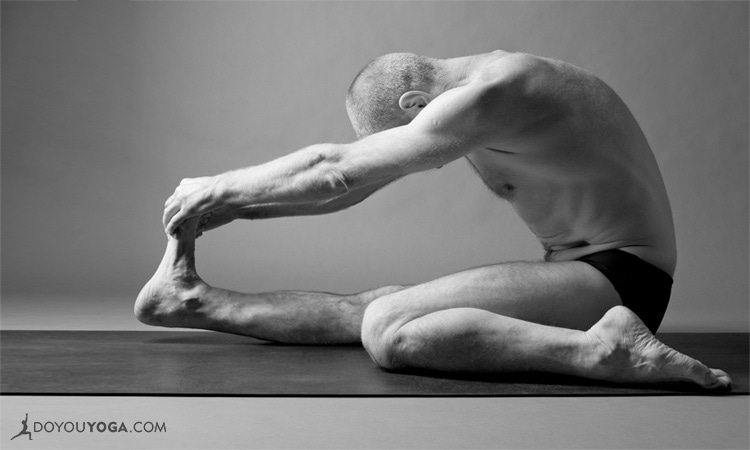Five sun salutations—check. Warriors one, two, and three—did them all. One-legged balancing poses—done.
By the time you come down to the mat to stretch in yoga class, you’re probably ready to relax. Well, think again: Seated poses require the same level of awareness and engagement as any and all of the standing poses—if not more.
The Danger of Hyperextension
For starters, muscle engagement prevents hyperextension, which is a movement or extension beyond the normal, healthy limits of a joint. When you hyperextend, let’s say, your knee, the ligaments that serve to stabilize the knee joint become overstretched.
Once elongated, ligaments, which lack elasticity, never return to their proper state. Over time, the knee joint becomes weaker and instable, often leading to pain and even injury.
When you stretch with adequate muscle engagement, however, it’s nearly impossible to hyperextend. Don’t believe me? Try this: standing with both feet parallel, bend your knees slightly, then lift and spread your toes. Feel the muscles of your legs hug to all sides of the bones.
Now, maintaining the muscle engagement you just created, press the mounds of your big toes down as you begin to straighten your legs. If you keep the engagement of the legs, your knees will not extend beyond what is straight.
For those of you who are experts at hyperextending, don’t be surprised if your knees still feel bent. You’re body’s perception of what straight legs feel like is most likely a hyperextension in the knee joint.
The Threat of Slow Motion Injury
Beyond hyperextension, passively stretching can result in a muscle pull or tear that occurs little by little over time, what is known as a slow motion injury.
The concept is perhaps easier understood once you know the logistics of stretching. Muscles, such as your hamstrings, are made up of hundreds, even thousands, of muscle fibers. All of those thousands of individual fibers have various stretch limits.
When you stretch without proper muscle engagement, the tensile stress isn’t distributed properly, and tension is placed on the shortest muscle fibers, which are the ones that reach their stretch capacity first. Tears happen one, two, six, ten fibers at a time, and may take weeks or months to become an injury.
When you engage your legs, however, all of the fibers integrate—creating harmony in the muscle. Supported by all of the other fibers, the shorter fibers no longer take the brunt of the work, and the entire muscle is lengthened.
Why Muscle Engagement Matters
Stretching with muscle energy is not only an issue of safety, but also of efficiency.
While it may seem counter intuitive, stretching with engagement will actually allow you to move deeper in a pose. Without active engagement, you continue to stretch the already flexibly muscles and tendons of your body by default.
Bring the body into harmony with integration, and less flexible muscles and tendons are given their opportunity to open and lengthen.
And you actually feel more when you stretch actively. Try it the next time you’re on your mat: in a seated posture, engage by flexing your feet, straightening your ankles by pressing through the inner edges of your feet, and pulling back and pressing down through the pinkie sides.
Play with engaging and relaxing your feet, and notice the difference you will feel in your body.


